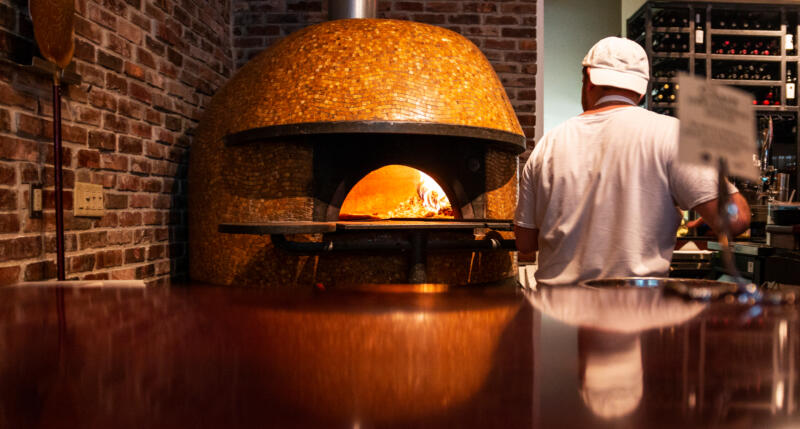Pizza: where crust can make or break the game. Some swear by the crisp edge of a well-done base, while others favor the gentle touch of a regular bake.

Dive in with us as we navigate this crusty debate and delve into pizza’s defining crunch.
In this article:
Understanding Well-Done Pizza
Well-done pizza, as the name suggests, is pizza that is baked longer than usual.
This extended baking time results in a pizza with a darker, crispier crust and a well-caramelized topping.

The process of making well-done pizza involves baking the pizza at a high temperature for a longer duration.
This technique allows the crust to develop a deep, golden-brown color and a robust flavor profile. The crust is crisp and crunchy, providing pure joy for those who are crazy about that perfect bite of texture.
The toppings, too, undergo a transformation. The flavors are more pronounced, with the caramelization process enhancing the natural sweetness of the ingredients.
The cheese is bubbly and browned, adding a smoky note to the pizza.
Exploring Regular-Baked Pizza
Regular-baked pizza, on the other hand, is the traditional method of baking pizza.
This method involves baking the pizza at a moderate temperature until the crust is golden and the cheese is melted.
The differences in cooking time and temperature between regular-baked and well-done pizza are significant.

Regular-baked pizza is typically cooked at a lower temperature and for a shorter time, resulting in a softer crust and less browning of the toppings.
The taste and texture of regular-baked pizza are distinct. The crust is softer and chewier, and the toppings retain more of their original flavors.
The cheese is melted and creamy, and the overall taste of the pizza is milder compared to well-done pizza.
The Pros and Cons of Well-Done Pizza

Well-done pizza has its advantages. The enhanced flavor and caramelization that result from the longer baking time can elevate the pizza to a gourmet level.
The crust becomes crispier, providing a delightful contrast to the soft toppings.
The reduced moisture content ensures that the pizza doesn’t become soggy, even with generous toppings.
However, well-done pizza also has its drawbacks. There’s a risk of the pizza becoming dry or overcooked if left in the oven for too long.

The longer cooking time also means you’ll have to wait a bit longer to enjoy your pizza.
Comparing Taste and Texture
Taste
Well-done pizza offers a unique taste profile. The extended baking time allows the flavors to develop more fully, resulting in a pizza that is rich and robust.
The crust takes on a toasty flavor, and the toppings, particularly the cheese, develop a delightful caramelized taste.
The overall flavor is more intense and complex compared to regular-baked pizza.
Texture
The texture of well-done pizza is another distinguishing feature. The crust offers a crisp, firm texture, delivering a delightful crunch in every bite.
The toppings, while well-cooked, retain their integrity and don’t become mushy.
When compared to regular-baked pizza, well-done pizza stands out for its bold flavors and crunchy texture.
Regular-baked pizza, with its softer crust and milder flavors, offers a different but equally enjoyable experience.
The choice between the two typically hinges on personal preference.
Personal Preference and Variations
Pizza, like any food, is highly subjective.
Some people love the intense flavors and crispy texture of well-done pizza, while others prefer the softer, milder taste of regular-baked pizza. There’s no right or wrong choice, just different preferences.
Pizza baking styles also vary widely across regions and cultures.
In some parts of Italy, for example, pizza is traditionally baked in a wood-fired oven until it’s well done, while in other regions, a softer, less-cooked pizza is preferred.
In the United States, preferences can vary from city to city, with some places famous for their crispy, thin-crust pizzas and others known for their soft, deep-dish pies.
Pizza’s charm lies in its adaptability. Feel free to tweak baking times and temperatures to discover your ideal pizza.
Whether you prefer your pizza well-done or regular-baked, the most important thing is to enjoy the process and the result.
Conclusion
Whether you’re a fan of well-done pizza with its robust flavors and crispy crust, or you prefer the softer, milder taste of regular-baked pizza, there’s a pizza out there for you.
So, dive in, experiment, and above all, savor your pizza!
We’d love to hear your thoughts on this topic. Do you have a preference for well-done or regular-baked pizza?
Have you experimented with different baking methods?
Share your experiences and questions in the comments below.